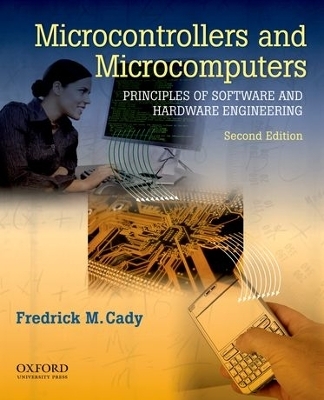
Microcontrollers and Microcomputers Principles of Software and Hardware Engineering
Oxford University Press Inc (Verlag)
978-0-19-537161-1 (ISBN)
Since the text does not focus on a particular processor, it can be used with processor-specific material - such as manufacturer's data sheets and reference manuals - or with texts, including author Fredrick M. Cady's Software and Hardware Engineering: Motorola M68HC11 or Software and Hardware Engineering: Motorola M68HC12.
Now fully updated, the second edition covers the fundamental operation of standard microcontroller features, including parallel and serial I/O interfaces, interrupts, analog-to-digital conversion, and timers, focusing on the electrical interfaces as needed. It devotes one chapter to showing how a variety of devices can be used, and emphasizes C program software development, design, and debugging.
Fredrick M. Cady is an Emeritus Professor of Electrical and Computer Engineering at Montana State University. He has been honored with several teaching awards, including M.S.U. Bozeman Mortar Board Professor of the Month, M.S.U. Alumni-Chamber of Commerce Award for Excellence, and the Phi Kappa Phi Anna Krueger Fridley Award for Distinguished Teaching.
1: INTRODUCTION; 1.1 Computers, Microprocessors, Microcomputers, Microcontrollers; 1.2 Moore's Law; 1.3 Microcontrollers; 1.4 Some Basic Definitions; 1.5 Notation; 1.6 Study Plan; 2: GENERAL PRINCIPLES OF MICROCONTROLLERS; 2.1 Introduction; 2.2 A Typical Microcontroller; 2.3 The Picocontroller; 2.4 The Microcontroller's Memory; 2.5 The Central Processor Unit; 2.6 Timing; 2.7 The I/O Interface; 2.8 The Address, Data, and Control Buses; 2.9 Some More Instructions; 2.10 The Final Picocontroller Design; 2.11 Software/Firmware Development; 2.12 The Software Development Tool Set; 2.13 Remaining Questions; 2.14 Conclusion and Chapter Summary Points; 2.15 Problems; 3: STRUCTURED PROGRAM DESIGN; 3.1 The Need for Software Design; 3.2 The Software Development Process; 3.3 Top-Down Design; 3.4 Design Partitioning; 3.5 Bottom-Up Design; 3.6 The Real-World Approach; 3.7 Types of Design Activity; 3.8 Design Tools; 3.10 Structured Programming in Assembly Language; 3.11 Program Comments; 3.12 Software Documentation; 3.13 A Top Down Design Example; 3.14 Chapter Summary Points; 3.15 Bibliography and Further Reading; 3.16 Problems; 4: INTRODUCTION TO THE CPU: REGISTERS AND CONDITION CODES; 4.1 Introduction; 4.2 CPU Registers; 4.3 Register Transfers; 4.4 The Condition Code Register; 4.5 The Programmer's Model; 4.6 Conclusion and Chapter Summary Points; 4.7 Problems; 5: MEMORY ADDRESSING MODES; 5.1 Introduction; 5.2 Addressing Terminology; 5.3 Memory Types; 5.4 Computer Types and Memory Maps; 5.5 Memory Architectures; 5.6 Addressing Modes; 5.7 Stack Addressing; 5.8 Chapter Conclusion and Summary Points; 5.9 Problems; 6: ASSEMBLY LANGUAGE PROGRAMMING; 6.1 Assembly Language Programming Style; 6.2 Structured Assembly Language Programming; 6.3 Interprocess Communication; 6.4 Assembly Language Tricks of the Trade; 6.5 Making it Look Pretty; 6.6 Conclusion and Chapter Summary Points; 6.7 Bibliography and Further Reading; 6.8 Problems; 7: C PROGRAMMING FOR EMBEDDED SYSTEMS; 7.1 Introduction; 7.2 Major Differences between C for Embedded and Desktop Applications; 7.3 Architecture of a C Program; 7.4 Assembly Language Interface; 7.5 Bits and Bytes - Accessing I/O Registers; 7.6 Interrupts; 7.7 Conclusion and Chapter Summary Points; 7.8 Bibliography and Further Reading; 7.9 Problems; 8: DEBUGGING MICROCONTROLLER SOFTWARE AND HARDWARE; 8.1 Introduction; 8.2 Program Debugging; 8.3 Debugging Your Code; 8.4 Debugging Tools; 8.5 Typical Assembly Language Program Bugs; 8.6 Debugging and Testing C Programs; 8.7 Other Debugging Techniques; 8.8 Conclusion and Chapter Summary Points; 8.9 Bibliography and Further Reading; 8.10 Problems; 9: COMPUTER BUSES AND PARALLEL I/O; 9.1 Introduction; 9.2 The Computer Bus; 9.3 I/O Addressing; 9.4 More Bus Ideas; 9.5 Microcontroller I/O; 9.6 More I/O Ideas; 9.7 I/O Software; 9.8 Conclusion and Chapter Summary Points; 9.9 Problems; 10: INTERRUPTS AND REAL-TIME EVENTS; 10.1 Introduction; 10.2 The Interrupt Process; 10.3 Multiple Sources of Interrupts; 10.4 Simultaneous Interrupts - Priorities; 10.5 Nested Interrupts; 10.6 Other Interrupts; 10.7 The Interrupt Service Routine or Interrupt Handler; 10.8 An Interrupt Program Template; 10.9 Advanced Interrupts; 10.10 Watchdog Timer or Computer Operating Properly (COP); 10.11 Real-Time Interrupt; 10.12 Conclusion and Chapter Summary Points; 10.13 Problems; 11: MEMORY; 11.1 Introduction; 11.2 A Short History of Random-Access Memory; 11.3 Semiconductor Memory; 11.4 Memory Timing Requirements; 11.5 Chapter Conclusion and Summary Points; 11.6 Problems; 12: SERIAL I/O; 12.1 Introduction; 12.2 The Asynchronous Serial Communication System; 12.3 Standards for the Asynchronous Serial I/O Interface; 12.4 Asynchronous Serial Hardware Interfaces; 12.5 ASCII Data and Control Codes; 12.6 Asynchronous Data Flow Control; 12.7 Debugging and Trouble Shooting; 12.8 Asynchronous Serial I/O Software; 12.9 Synchronous Serial Peripheral Interface (SPI); 12.10 SPI Interface Examples; 12.11 Inter-Integrated Circuit (IIC or I2C); 12.12 The Controller Area Network (CAN) Bus; 12.13 Conclusion and Chapter Summary Points; 12.14 Problems; 13: ANALOG INPUT AND OUTPUT; 13.1 Introduction; 13.2 Data Acquisition and Conversion; 13.3 Shannon's Sampling Theorem and Aliasing; 13.4 A/D Errors; 13.5 Choosing the A/D Converter; 13.6 The Analog-to-Digital Converter Interface; 13.7 Analog-to-Digital Converter Types; 13.8 Digital-to-Analog Conversion; 13.9 Other Analog I/O Methods; 13.1 Conclusion and Chapter Summary Points; 13.11 Problems; 14: COUNTERS AND TIMERS; 14.1 Introduction; 14.2 The Timer/Counter; 14.3 Pulse-Width Modulation (PWM) Waveforms; 14.4 "Real" Real-Time Clock - Clock Time; 14.5 Conclusion and Chapter Summary Points; 14.6 Problems; 15: SINGLE-CHIP MICROCONTROLLER INTERFACING TECHNIQUES; 15.1 Microcontroller Chip I/O; 15.2 Simple Input Devices; 15.3 Simple Display Devices; 15.4 Parallel I/O Expansion; 15.5 Parallel I/O Electronics; 15.6 Temperature Measurements; 15.7 Motor Control; 15.8 Conclusion and Chapter Summary Points; 15.9 Bibliography and Further Reading; 15.10 Problems; 16: REAL-TIME OPERATING SYSTEMS; 16.1 Introduction; 16.2 The Real-Time Operating System (RTOS); 16.3 Conclusion and Chapter Summary Points; 16.4 Bibliography and Further Reading; 16.5 Problems; APPENDIX A: BINARY CODES; A.1 Binary Codes Review; A.2 Problems
| Erscheint lt. Verlag | 17.9.2009 |
|---|---|
| Zusatzinfo | numerous black and white figures and tables |
| Verlagsort | Oxford |
| Sprache | englisch |
| Maße | 188 x 232 mm |
| Gewicht | 773 g |
| Themenwelt | Mathematik / Informatik ► Informatik ► Theorie / Studium |
| Informatik ► Weitere Themen ► Hardware | |
| ISBN-10 | 0-19-537161-5 / 0195371615 |
| ISBN-13 | 978-0-19-537161-1 / 9780195371611 |
| Zustand | Neuware |
| Informationen gemäß Produktsicherheitsverordnung (GPSR) | |
| Haben Sie eine Frage zum Produkt? |
aus dem Bereich


